Inpatient census 2019: hospital based complex clinical care and long stay
Results from the Hospital Based Complex Clinical Care (HBCCC) and Long Stay Census, carried out in March 2019. The data was collected as part of the Inpatient Census.
This document is part of a collection
1. Hospital Based Complex Clinical Care and Long Stay Patients
Number of HBCCC and Long Stay patients in Census
Overall, there were 1,635 Hospital Based Complex Clinical Care (HBCCC) or Long Stay (LS) patients at the 2019 Census. Of these, 889 (54%) were receiving HBCCC and 746 (46%) were LS. LS is defined here as patients in hospital for at least 6 months but not in receipt of HBCCC.
Of the 1,635 HBCCC or LS patients, 1,305 (80%) were occupying a Mental Health, Learning Disability or Addiction Inpatient Bed in an NHS Scotland Facility, 239 patients (15%) were in a General Acute / Community Hospital NHS Scotland facility, while 91 patients (6%) were treated outwith but funded by NHS Scotland (e.g. Private hospitals or NHS facilities elsewhere in the UK). See table 1 for a more detailed breakdown and comparisons to 2018 data. There are also a very small number of patients treated within NHS Scotland but funded externally.
Table 1: Number of HBCCC and LS patients by Census part, 2018 - 2019
| Inpatient Census | All Patients | HBCCC Patients | LS Patients | |||
|---|---|---|---|---|---|---|
| 2018 | 2019 | 2018 | 2019 | 2018 | 2019 | |
| Part 1: Mental Health Bed Census | 1,315 | 1,305 | 672 | 684 | 643 | 621 |
| Part 2: Out of Scotland NHS Placements | 166 | 91 | 42 | 41 | 124 | 50 |
| Part 3: HBCCC & LS (general acute) | 292 | 239 | 223 | 164 | 69 | 75 |
| All HBCCC patients in Inpatient Census | 1,773 | 1,635 | 937 | 889 | 836 | 746 |
Age and Gender
Figure 2 shows the age and gender breakdown of patients receiving HBCCC at the 2019 Census. Some key points include:
- Of the 889 HBCCC patients, 487 (55%) were male, while 394 (44%) were female. Data was missing/unknown for 8 patients (1%). Males represented 49% of the general Scottish population in 2018 based on National Record of Scotland (NRS) Mid-Year estimates, suggesting males are over represented in HBCCC.
- Patients were mostly from the older age groups, 522 (59%) patients were aged 65 or over, a fall from 64% compared to 2018. A further 225 (25%) were aged 40 – 64 at the time of the 2019 Census. There were 130 (15%) patients aged 18 – 39 and 12 (1%) patients under 18 receiving HBCCC at 2019 Census.
- Gender differences described are influenced by age. At the 2019 Census for patients aged under 40, 61% were male. This is identical to the 2018 Census. Of those aged 40 – 64 years in 2019, 68% are male. At 65 or over this trend reverses with females making up 52% of this age group. This change will partly reflect the differing life expectancy of males (77.0 years, 2017) and females (81.1, 2017).
Figure 2: Males make up . the majority of HBCCC patients with female patients becoming more prevalent with age
Hospital Based Complex Clinical Care & Long Stay, NHS Scotland, March 2019 Census.
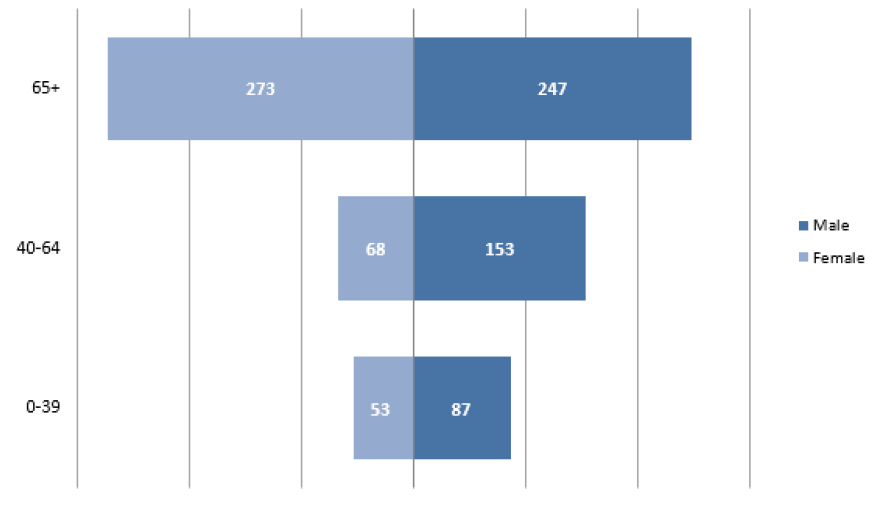
* Chart excludes those with unknown or refused gender
Figure 3 shows the age and gender breakdown of LS patients at the 2019 Census. Some key points include:
- Of the 746 patients, 474 (64%) were male, while 271 (36%) were female. Data was missing/unknown for 1 patient. Males represented 49% of the general Scottish population in 2018 based on NRS Mid-Year estimates, suggesting males are over represented.
- Patients were mostly from the older age groups, with 332 (45%) aged 40 – 64 years and a further 201 (27%) aged 65 or over. There were 196 (26%) LS patients aged 18 – 39 and 17 (2%) LS patients under 18 at 2019 Census.
- Gender differences described are influenced by age. For patients aged under 40, 66% are male, while an identical proportion of patients aged 40 – 64 years, 66%, are male. The proportion for the 65 or over group is 56% male. This change will partly reflect the differing life expectancy of males (77.0 years, 2017) and females (81.1, 2017).
Figure 3: Males make up the majority of LS patients
Hospital Based Complex Clinical Care & Long Stay, NHS Scotland, March 2019 Census
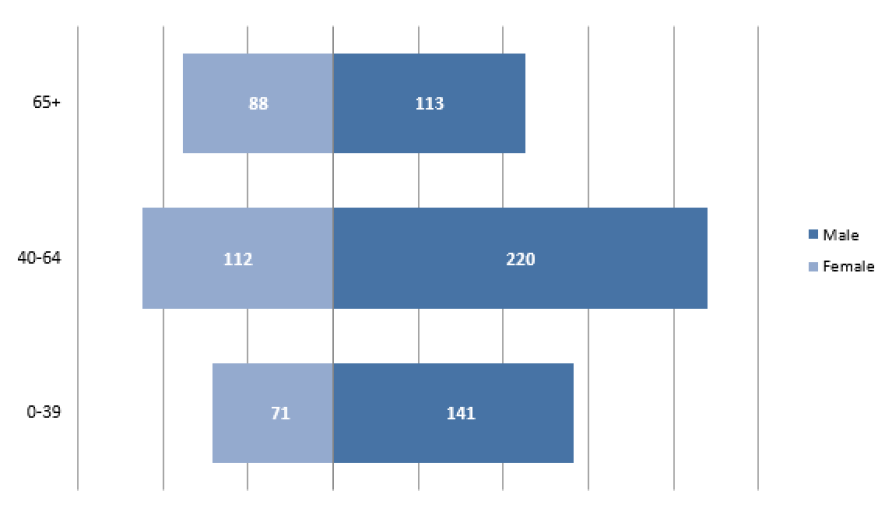
* Chart excludes those with unknown or refused gender
Ethnicity
The majority of HBCCC or LS patients at the 2019 Census, described themselves as being of White Scottish ethnicity, 1,229 (75%). A further 214 (13%) patients were of another White ethnicity. Information was not known or refused for 146 patients. See figure 4 for further details.
Figure 4: HBCCC or LS patients are overwhelmingly of White Scottish ethnicity where reported
Hospital Based Complex Clinical Care & Long Stay, NHS Scotland, March 2019 Census
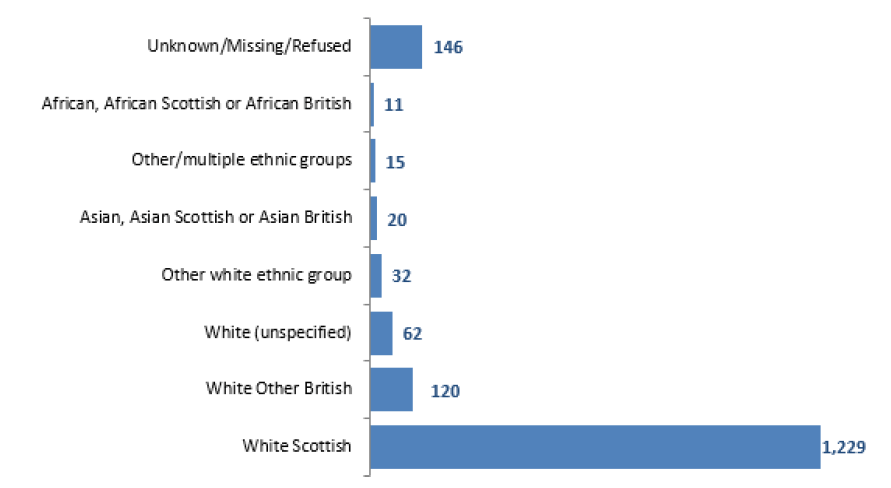
Consultant Specialty
As part of the Census, NHS Boards were asked to record the medical specialty of the consultants responsible for overseeing the treatment of each patient in the Census.
Of the 889 patients receiving HBCCC at the 2019 Census, 383 (43%) had a consultant who specialised in Psychiatry of Old Age, a fall from the 2018 figure of 47% but still higher than the 2017 figure of 36%. In 2019, 149 (17%) had a consultant specialising in General Psychiatry and 129 (15%) in Forensic Psychiatry. See figure 5 for further details.
Figure 5: The Large majority of HBCCC patients are treated in Psychiatric specialities
Hospital Based Complex Clinical Care & Long Stay, NHS Scotland, March 2019 Census
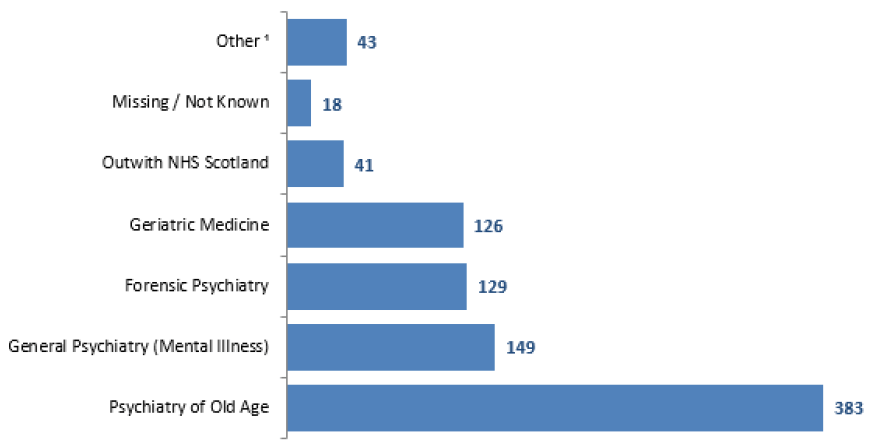
¹ Other includes a range of specialties with smaller numbers that have been aggregated to protect patient confidentiality
Of the 746 LS patients at the Census, 287 (38%) had a consultant who specialised in General Psychiatry, 146 (20%) had a consultant specialising in Forensic Psychiatry and 117 (16%) in Psychiatry of Old Age. See figure 6 for further details.
Figure 6: The large majority of LS patients are treated in Psychiatric specialties
Hospital Based Complex Clinical Care & Long Stay, NHS Scotland, March 2019 Census
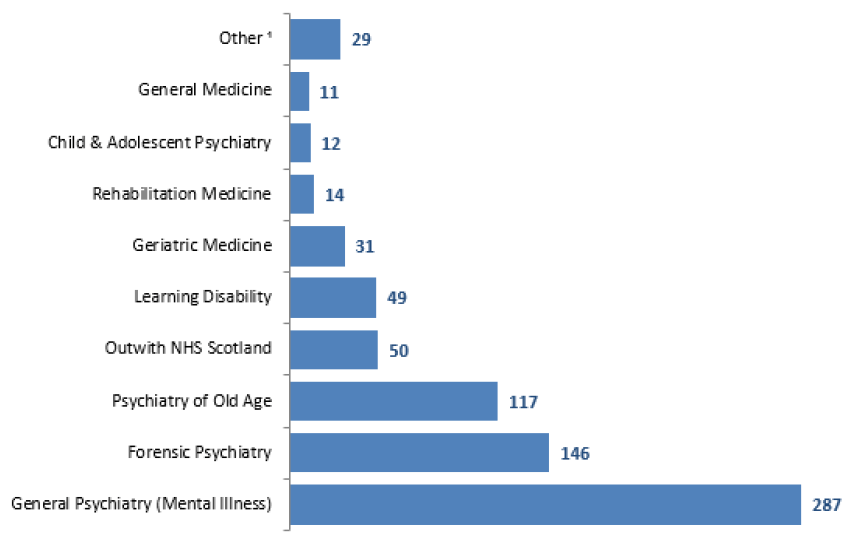
¹ Other includes a range of specialties with smaller numbers that have been aggregated to protect patient confidentiality as well as patients with a missing or unknown specialty
NHS Board Breakdown
NHS Greater Glasgow & Clyde were responsible for funding the treatment of 293 HBCCC patients (33%), followed by NHS Lothian with 275 (31%). NHS Greater Glasgow & Clyde’s proportion has risen from 30% at the last Census. NHS Lothian had the highest number in the 2018 Census and their proportion in 2019 dropped by 9%. NHS Shetland funded no HBCCC patients. A very small number of patients are included in this analysis that are treated in Scotland but funded from outside of NHS Scotland. See figure 7 for further details.
Figure 7: NHS Greater Glasgow & Clyde fund the largest number of HBCCC patients Hospital Based Complex Clinical Care & Long Stay, NHS Scotland, March 2019 Census
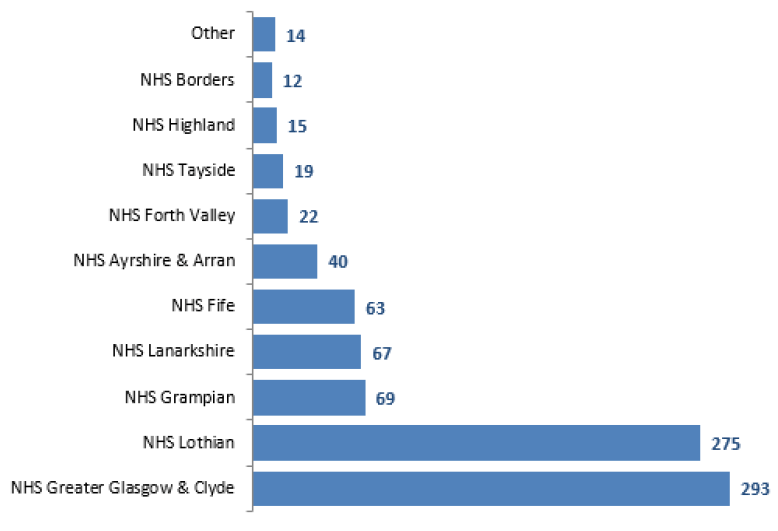
* Other includes NHS Boards with small numbers that have been combined to protect patient confidentiality
** A very small number of patients are included in this analysis that are treated in Scotland but funded from outside of NHS Scotland
NHS Lothian had the highest rate of HBCCC patients at 30.6 per 100,000 population. This is a fall from their figure of 42.4 patients per 100,000 population at the 2018 Census. NHS Greater Glasgow & Clyde (24.9) and NHS Fife (16.9) had the next highest rates. See figure 8 for further details.
Figure 8: NHS Lothian fund the highest rate of HBCCC patients per 100,000 population
Hospital Based Complex Clinical Care & Long Stay, NHS Scotland, March 2019 Census
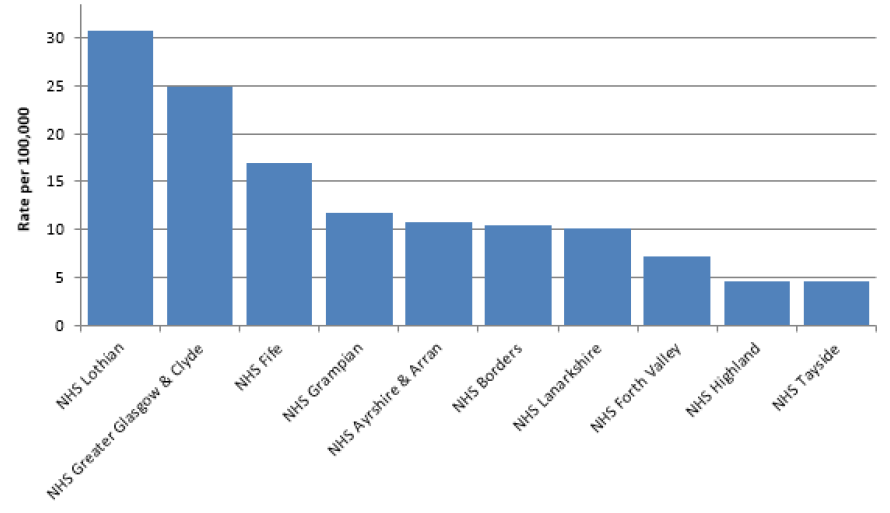
* Excludes Health Boards who have been suppressed to protect patient confidentiality
NHS Greater Glasgow & Clyde were responsible for funding the treatment of 171 LS patients (23%). The proportion of LS patients funded by NHS Greater Glasgow & Clyde remained the same compared to the 2018 Census. NHS Lothian had the next highest number with 170 (23%). See figure 9 for further details.
Figure 9: NHS Greater Glasgow & Clyde fund the largest number of LS patients
Hospital Based Complex Clinical Care & Long Stay, NHS Scotland, March 2019 Census
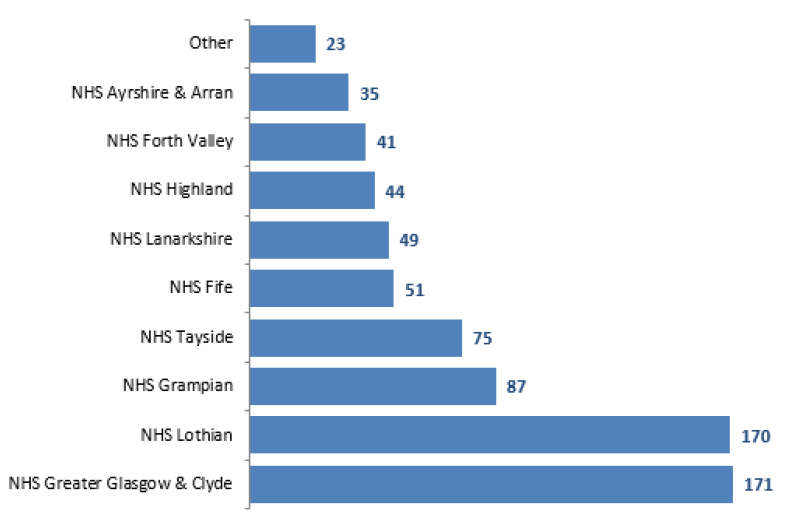
* Other includes NHS Boards with small numbers that have been combined to protect patient confidentiality
NHS Lothian is among the higher rates of LS patients at 18.9 per 100,000 population. NHS Tayside (18.0) is also among the higher rates. See figure 10 for further details.
Figure 10: NHS Lothian fund the highest rates of LS patients per 100,000 population.
Hospital Based Complex Clinical Care & Long Stay, NHS Scotland, March 2019 Census
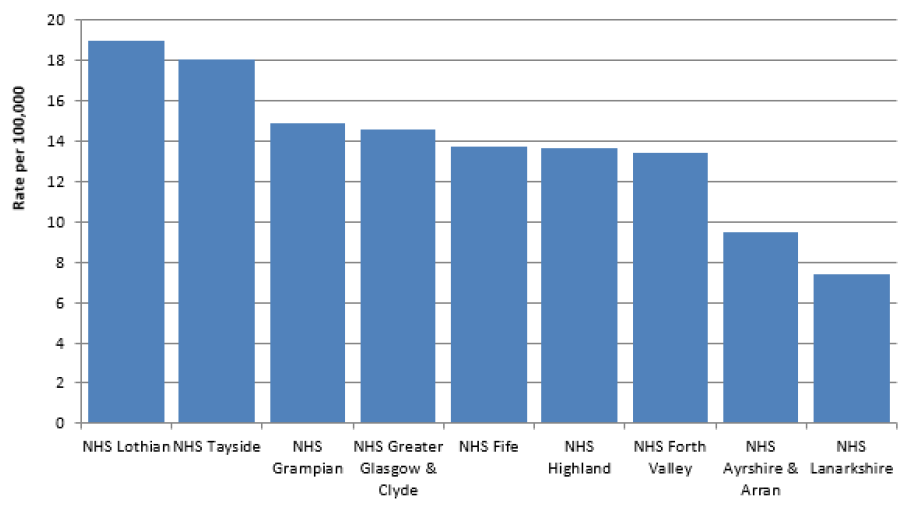
* Excludes Health Boards who have been suppressed to protect patient confidentiality
Local Authority Breakdown
Figure 11 provides analysis of patients in receipt of HBCCC by Local Authority of residence (based on the patient’s home postcode). Where a Local Authority has <5 patients in receipt of HBCCC the figure has been suppressed to protect patient confidentiality. The City of Edinburgh had more HBCCC patients than any other Local Authority at the 2019 Census with 159 patients (18%). Glasgow City had the next highest number with 145 (16%). The City of Edinburgh’s proportion of resident patients fell from 29% in 2018 to 18% in 2019.
Figure 11: The City of Edinburgh has the largest number of HBCCC patients by home postcode Hospital Based Complex Clinical Care & Long Stay, NHS Scotland, March 2019 Census
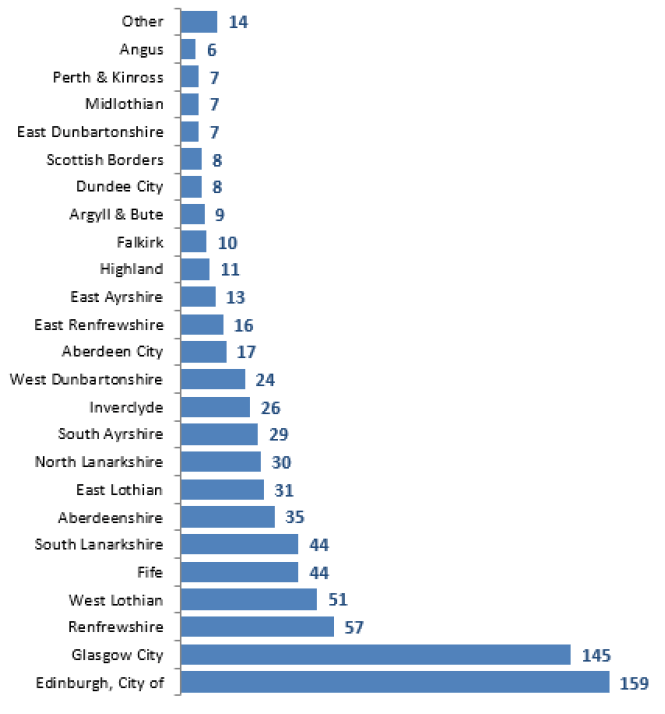
* Data unknown for 81 patients
**Other includes Local Authorities with small numbers that have been combined to protect patient confidentiality
Figure 12 provides analysis of LS patients by Local Authority of residence (based on the patient’s home postcode). As previously mentioned, where a Local Authority has <5 LS patients the figure has been suppressed to protect patient confidentiality. The City of Edinburgh had more LS patients than any other Local Authority at the 2019 Census with 119 patients (16%). Glasgow City had the next highest number with 104 (14%). Glasgow City had the highest number in the 2018 Census and their 2019 figure has fallen by 15.
Figure 12: The City of Edinburgh has the largest number of LS patients by home postcode Hospital Based Complex Clinical Care & Long Stay, NHS Scotland, March 2019 Census
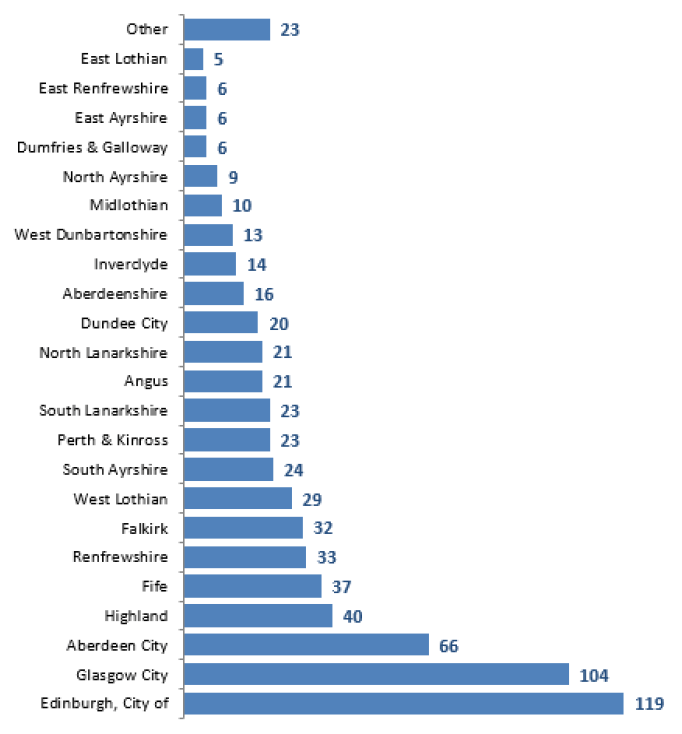
* Data unknown for 46 patients
**Other includes Local Authorities with small numbers that have been combined to protect patient confidentiality
Length of Stay in Hospital
NHS Boards were asked to record how long patients had been in hospital at the 2019 Census date. The average (median) time in hospital for HBCCC patients was 516 days (approximately 1 year and 5 months). For LS patients, the average (median) time in hospital was 548 days (approximately 1 year and 6 months). Both the HBCCC and LS median stays are shorter than reported in the 2018 Census. The spread of length of stay for patients can be seen in Table 2.
Table 2: Length of Stay, HBCCC and LS patients, 2018 - 2019
| Length of Stay | HBCCC Patients | LS Patients | ||
|---|---|---|---|---|
| 2018 | 2019 | 2018 | 2019 | |
| Less than 6 months | 269 | 240 | 0 | 0 |
| At least 6 months, less than 1 year | 119 | 129 | 238 | 251 |
| At least 1 year, less than 3 years | 265 | 256 | 308 | 288 |
| At least 3 year, less than 5 years | 119 | 111 | 104 | 76 |
| 5 years or more | 161 | 152 | 182 | 131 |
| Median | 539 | 516 | 649 | 548 |
* Admission date unknown for 1 patient in 2019
Health Conditions
NHS Boards were asked to return information on any health conditions a patient had been diagnosed with. Figure 13 shows the top six conditions for HBCCC and LS patients at the 2019 Census. The most prevalent was Mental Health with 738 (83%) HBCCC and 660 (88%) LS patients. Mental Health was also the most prominent condition in 2018.
Figure 13: Mental Health conditions are the most common diagnoses among HBCCC and LS patients
Hospital Based Complex Clinical Care & Long Stay, NHS Scotland, March 2019 Census
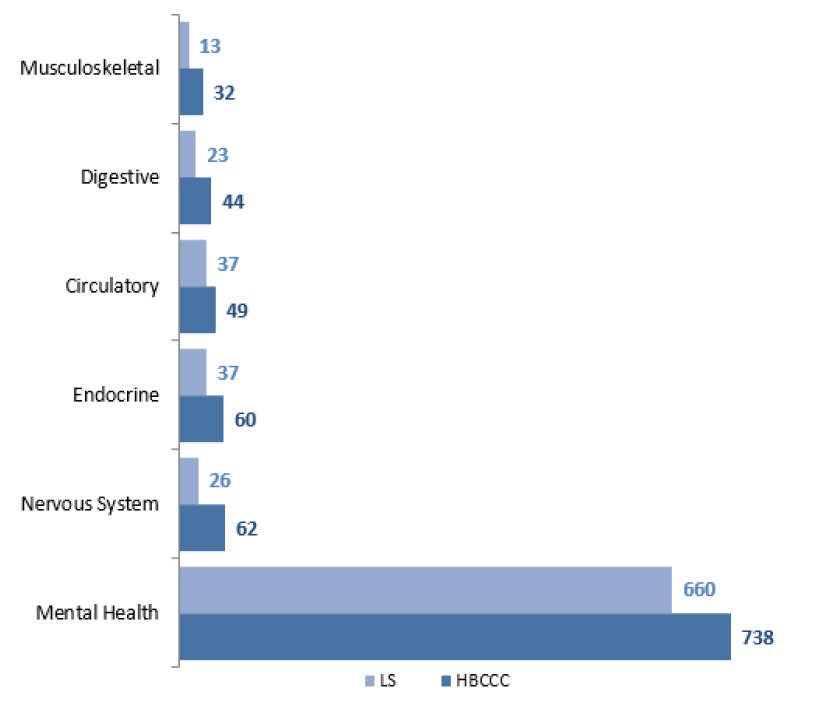
* Patients can have more than one condition
Contact
Email: Darren.Meek@gov.scot
There is a problem
Thanks for your feedback